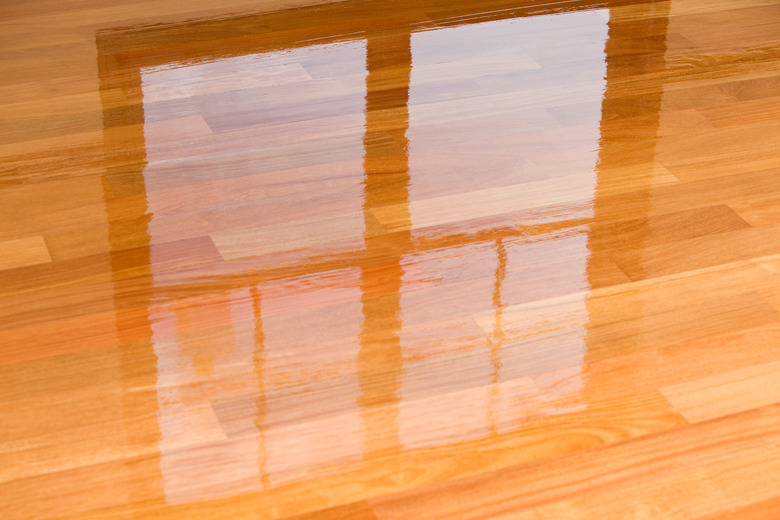How Long Does Polyurethane Take To Dry On Wood Floors?
As with paint, environmental factors, such as humidity and temperature, may affect how long a coat of polyurethane takes to dry on a wood floor. The formulation matters even more, as both water-based and oil-based polyurethanes work on wood floors and have totally different drying times. The polyurethane may be dry to the touch in four hours or so for water-based, but it takes 12 or more hours for the same level of dryness with an oil-based polyurethane. Don't let the lack of wetness fool you, however; the polyurethane needs ample time to cure before heavy furniture and rugs can be moved back into the room.
Water-Based Polyurethane Drying Time
Water-Based Polyurethane Drying Time
Water-based polyurethane generally dries in half or a third of the time it takes an oil-based polyurethane to dry in identical conditions. In other words, if you applied a coat of water-based polyurethane on the wood floor in one room and oil-based in an adjacent room on the same day and with each room at the same temperature, the water-based polyurethane would be ready for a second coat much sooner than the oil-based polyurethane.
Actual drying time varies based on the product formulation, but four to eight hours is realistic for the average water-based polyurethane. When it's dry to the touch, it's safe to apply another coat and to walk over it with clean socks when necessary since adding another coat means stepping on it. It's still best to minimize walking on the dry-to-the-touch polyurethane since even small bits of debris could end up in the new finish.
Oil-Based Polyurethane Drying Time
Oil-Based Polyurethane Drying Time
Oil-based polyurethane takes quite a bit longer to dry, about 12 to 24 hours on average. If it's humid and there isn't ample airflow or if the room is colder than recommended on the product label, expect an even longer drying time. All in all, applying a couple of coats of oil-based polyurethane usually spans a couple of days, while you may be able to apply all the coats of a water-based polyurethane in the same day under ideal conditions.
Oil-based is more durable than water-based polyurethane, and water-based seems to soak in a bit more at first, so for a smooth finish, water-based often needs twice as many coats compared to using oil-based polyurethane of comparable quality on the same floor. The best-quality water-based polyurethane products may require about the same number of coats or possibly just one more than the average oil-based polyurethane. Naturally, the more coats, the longer the total drying time from project start to finish. Much like paints, the better the polyurethane quality, the fewer coats necessary to achieve the desired results.
Drying vs. Curing Time
Drying vs. Curing Time
Polyurethane and other protective coatings might feel dry to the touch within hours, but they're nowhere near ready for the usual heavy traffic a floor receives. All types of polyurethane need time to cure or solidify inside and out so the coating is no longer permeable or easily damaged by even minor abrasives, such as a dog's claws. Much of the odor also dissipates during this time, which matters because uncured oil-based products emit strong fumes you'd probably rather not smell for hours at a time.
Water-based polyurethane generally takes one to two weeks to completely cure, while oil-based polyurethane takes up to a month. One product formulation varies from the next, even for the same general type of polyurethane, so it's best to read the product label to determine when to move furniture back into the room. Even if it's safe to put the furniture back in the room in two to four days, wait about two weeks before setting rugs atop the new floor finish, as the rug hinders the polyurethane's ability to properly cure.
